Financial Performance Analysis: Commonwealth Bank Annual Report
VerifiedAdded on 2022/10/10
|13
|1412
|285
Report
AI Summary
This report provides a comprehensive analysis of the Commonwealth Bank's annual report, covering various aspects of its financial performance and strategic positioning. The analysis begins with an examination of the bank's competitive strategy, highlighting risks and opportunities in the industry. It then delves into the accounting policies, focusing on how key financial instruments are measured and reported. A significant portion of the report is dedicated to financial analysis, including ratio analysis (operating profit margin, net profit margin, and debt-equity ratio) and cash flow analysis, revealing trends and insights into the bank's operational efficiency and financial health. Furthermore, the report explores the bank's environmental, social, and corporate governance (ESG) practices, assessing their contribution to the company's overall development and stakeholder relations. A comparative analysis against Coca-Cola Amatil provides further context, evaluating the Commonwealth Bank's financial policies and environmental practices relative to an industry peer. The report concludes with a discussion of the interrelationship between financial policies and strategy, emphasizing the importance of these factors in the bank's overall development. References to relevant academic sources are included throughout the analysis.
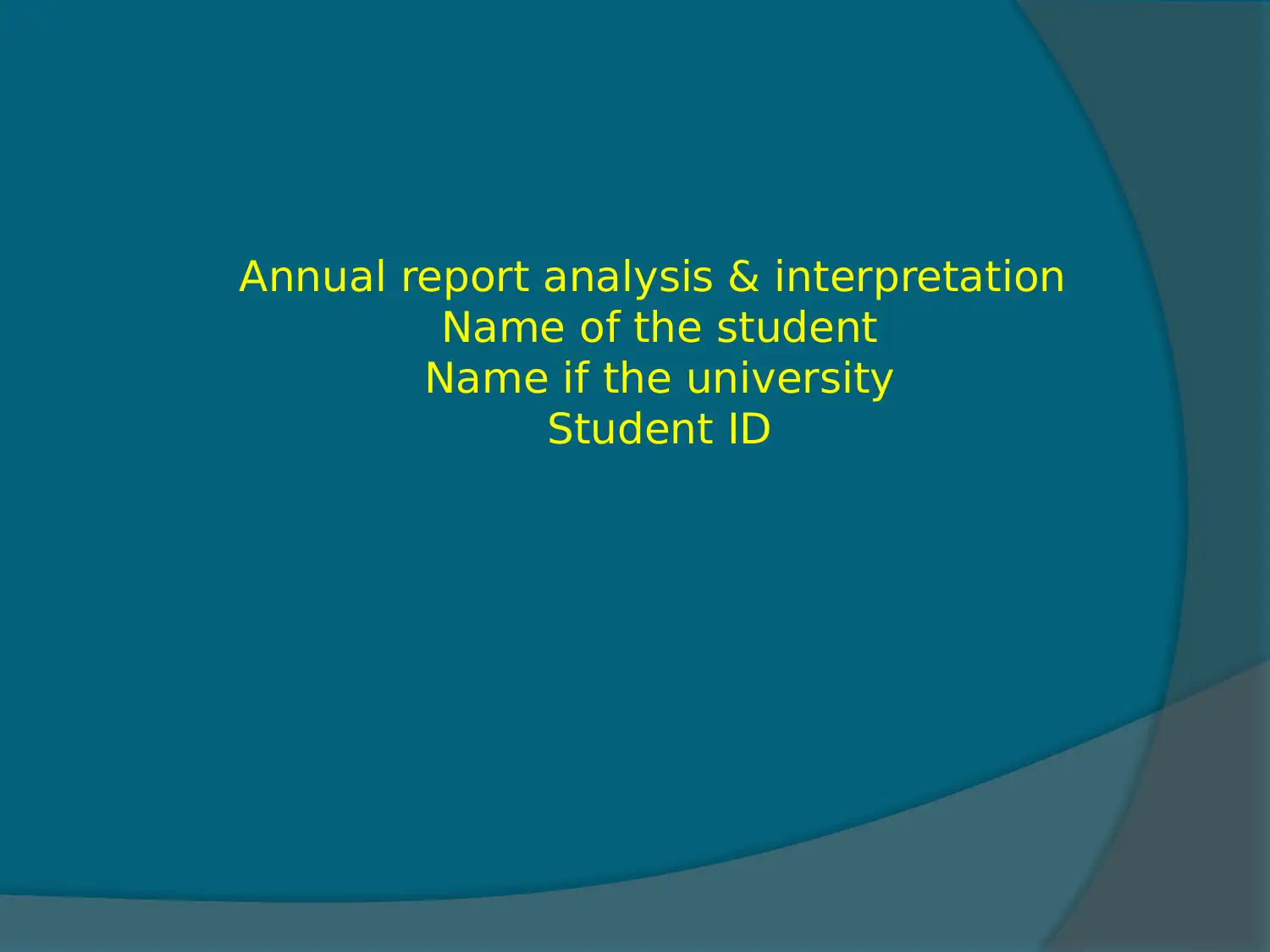
Annual report analysis & interpretation
Name of the student
Name if the university
Student ID
Name of the student
Name if the university
Student ID
Paraphrase This Document
Need a fresh take? Get an instant paraphrase of this document with our AI Paraphraser
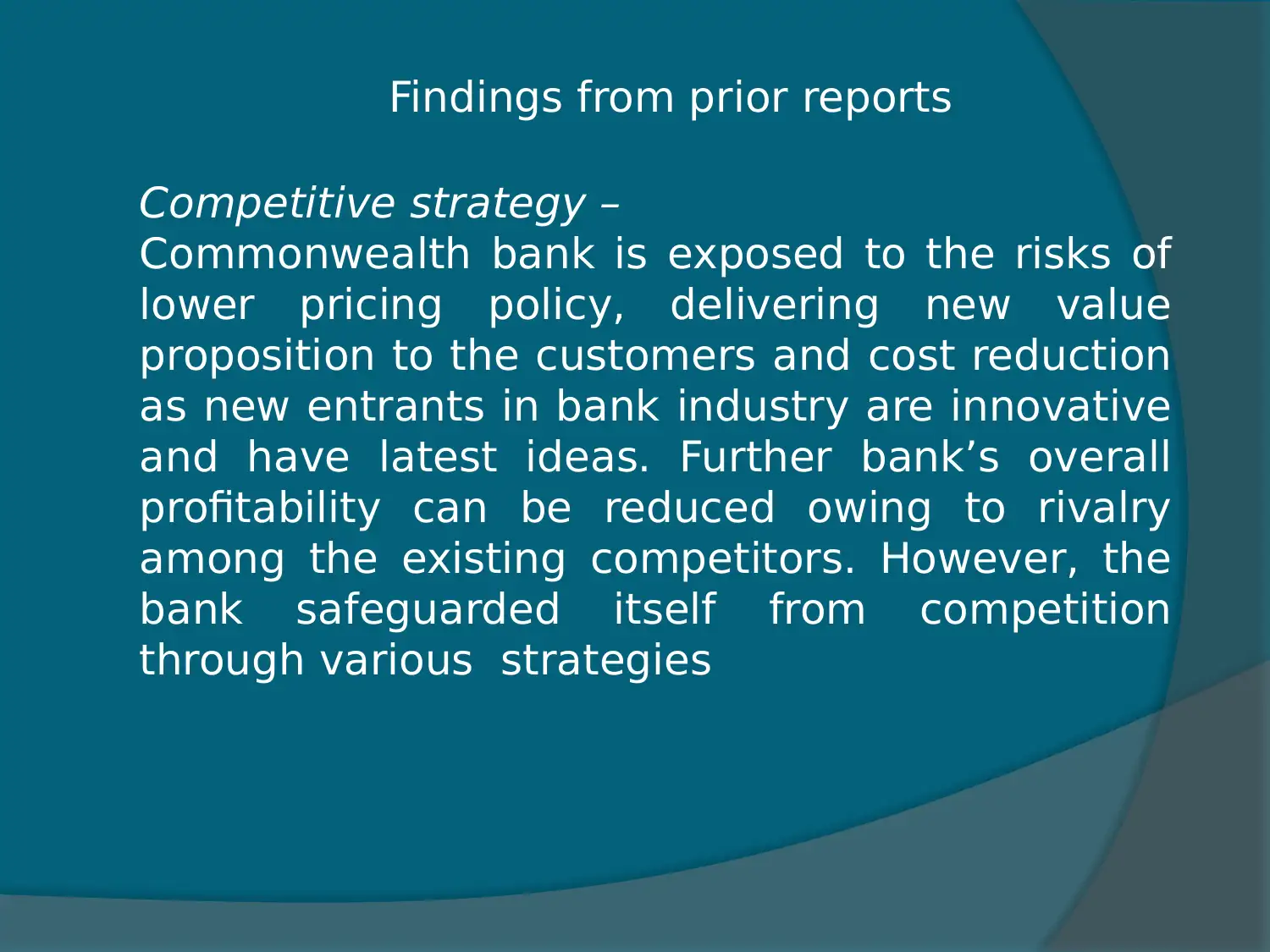
Findings from prior reports
Competitive strategy –
Commonwealth bank is exposed to the risks of
lower pricing policy, delivering new value
proposition to the customers and cost reduction
as new entrants in bank industry are innovative
and have latest ideas. Further bank’s overall
profitability can be reduced owing to rivalry
among the existing competitors. However, the
bank safeguarded itself from competition
through various strategies
Competitive strategy –
Commonwealth bank is exposed to the risks of
lower pricing policy, delivering new value
proposition to the customers and cost reduction
as new entrants in bank industry are innovative
and have latest ideas. Further bank’s overall
profitability can be reduced owing to rivalry
among the existing competitors. However, the
bank safeguarded itself from competition
through various strategies
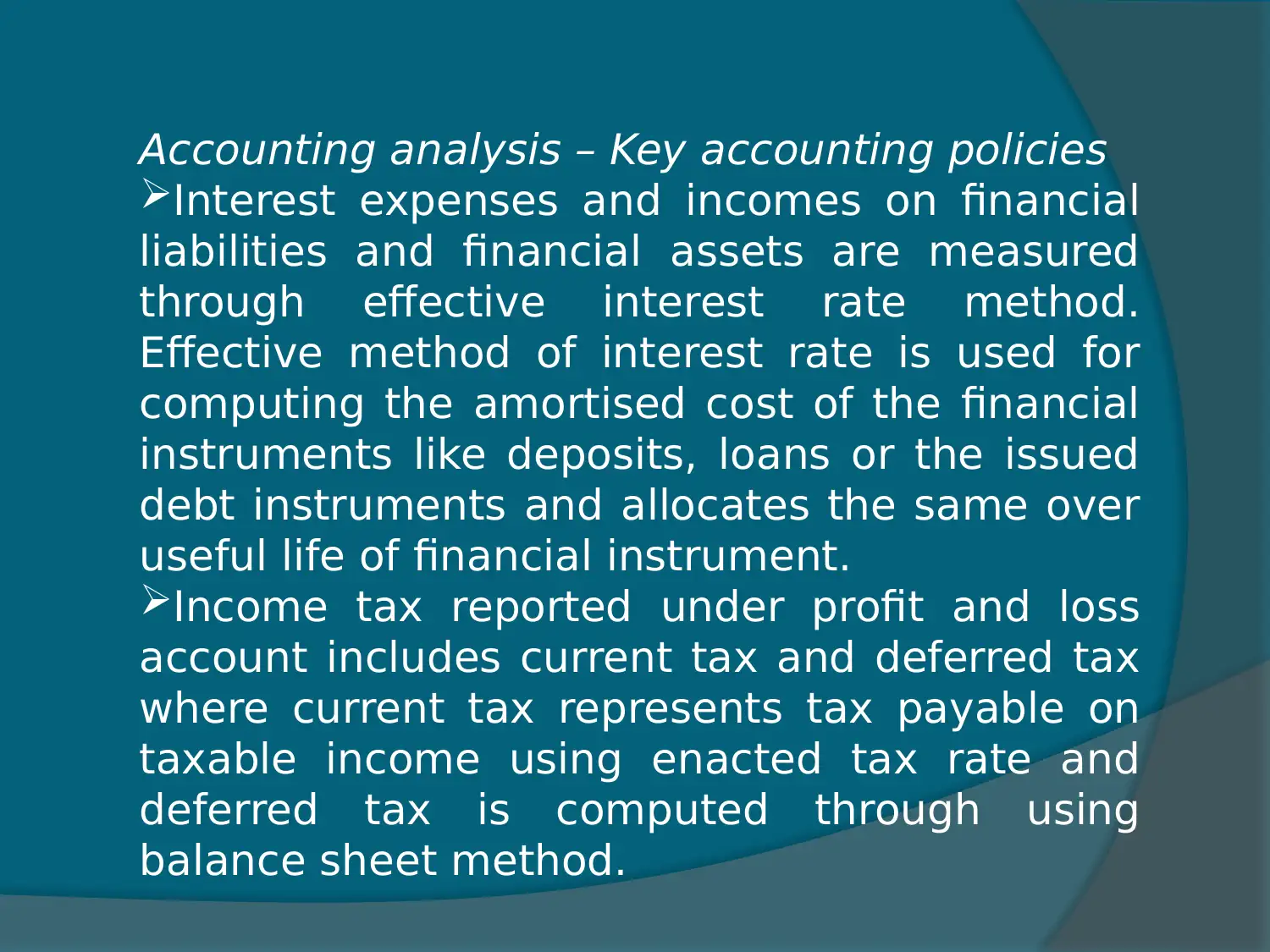
Accounting analysis – Key accounting policies
Interest expenses and incomes on financial
liabilities and financial assets are measured
through effective interest rate method.
Effective method of interest rate is used for
computing the amortised cost of the financial
instruments like deposits, loans or the issued
debt instruments and allocates the same over
useful life of financial instrument.
Income tax reported under profit and loss
account includes current tax and deferred tax
where current tax represents tax payable on
taxable income using enacted tax rate and
deferred tax is computed through using
balance sheet method.
Interest expenses and incomes on financial
liabilities and financial assets are measured
through effective interest rate method.
Effective method of interest rate is used for
computing the amortised cost of the financial
instruments like deposits, loans or the issued
debt instruments and allocates the same over
useful life of financial instrument.
Income tax reported under profit and loss
account includes current tax and deferred tax
where current tax represents tax payable on
taxable income using enacted tax rate and
deferred tax is computed through using
balance sheet method.
⊘ This is a preview!⊘
Do you want full access?
Subscribe today to unlock all pages.

Trusted by 1+ million students worldwide
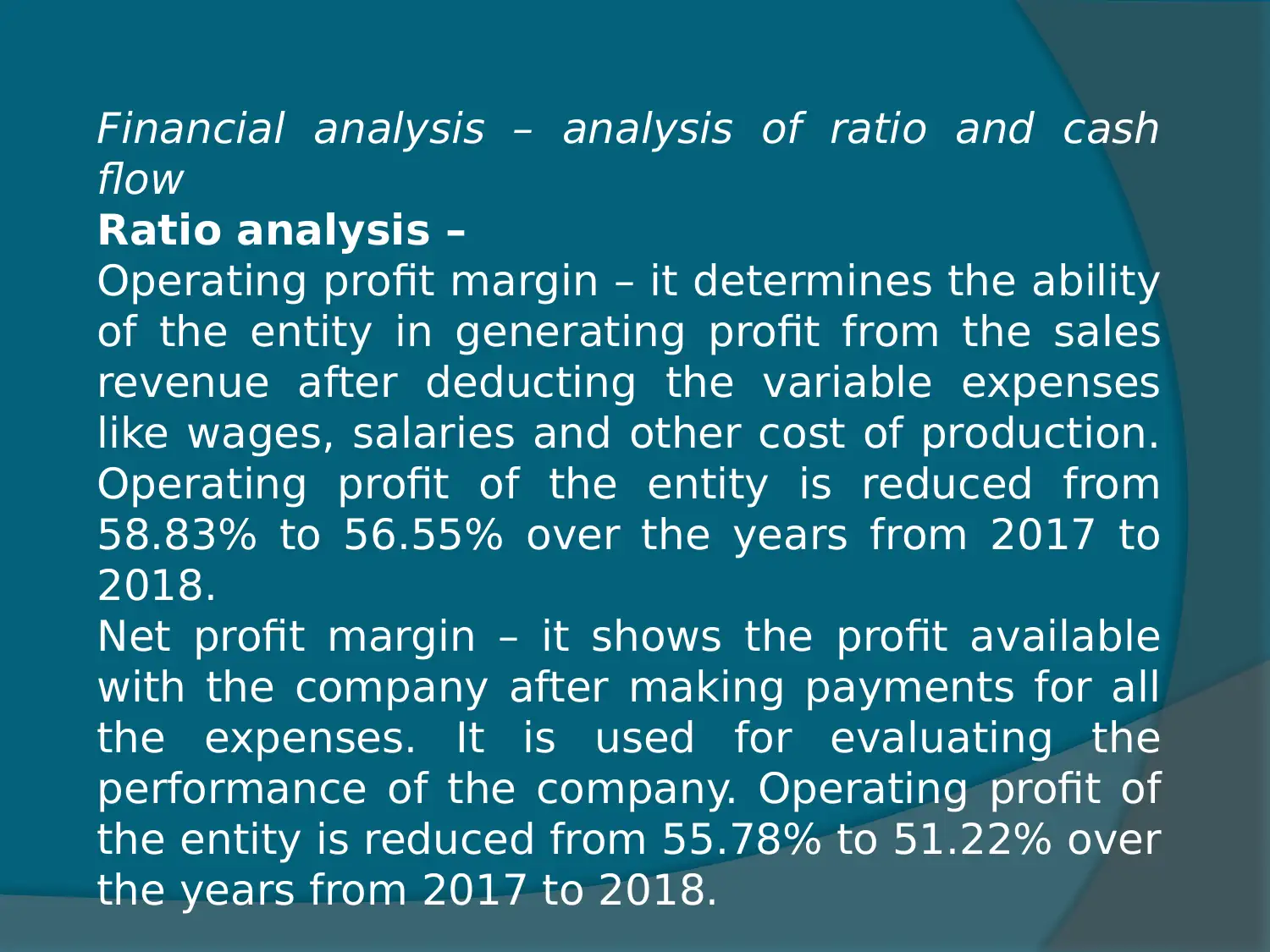
Financial analysis – analysis of ratio and cash
flow
Ratio analysis –
Operating profit margin – it determines the ability
of the entity in generating profit from the sales
revenue after deducting the variable expenses
like wages, salaries and other cost of production.
Operating profit of the entity is reduced from
58.83% to 56.55% over the years from 2017 to
2018.
Net profit margin – it shows the profit available
with the company after making payments for all
the expenses. It is used for evaluating the
performance of the company. Operating profit of
the entity is reduced from 55.78% to 51.22% over
the years from 2017 to 2018.
flow
Ratio analysis –
Operating profit margin – it determines the ability
of the entity in generating profit from the sales
revenue after deducting the variable expenses
like wages, salaries and other cost of production.
Operating profit of the entity is reduced from
58.83% to 56.55% over the years from 2017 to
2018.
Net profit margin – it shows the profit available
with the company after making payments for all
the expenses. It is used for evaluating the
performance of the company. Operating profit of
the entity is reduced from 55.78% to 51.22% over
the years from 2017 to 2018.
Paraphrase This Document
Need a fresh take? Get an instant paraphrase of this document with our AI Paraphraser
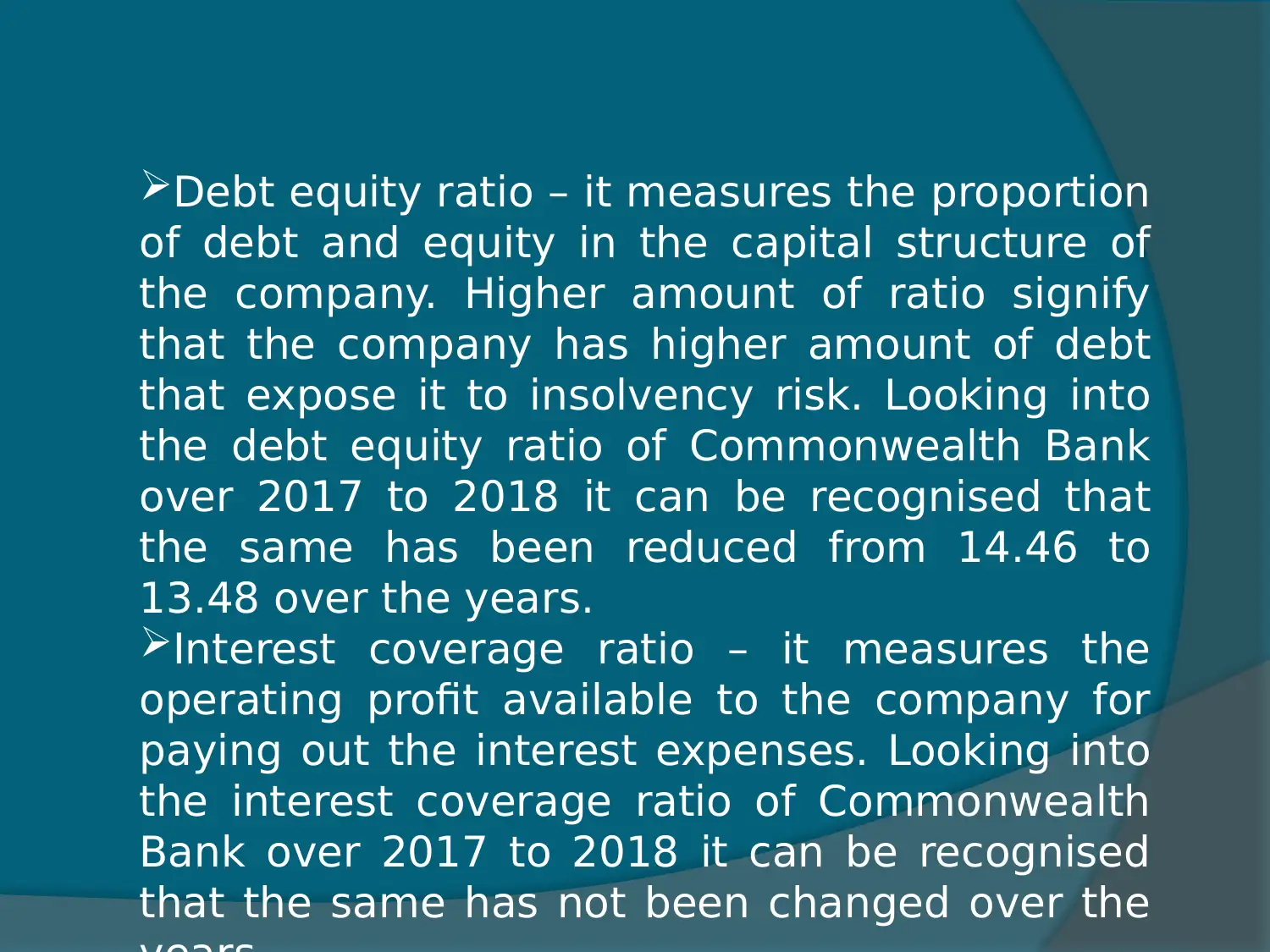
Debt equity ratio – it measures the proportion
of debt and equity in the capital structure of
the company. Higher amount of ratio signify
that the company has higher amount of debt
that expose it to insolvency risk. Looking into
the debt equity ratio of Commonwealth Bank
over 2017 to 2018 it can be recognised that
the same has been reduced from 14.46 to
13.48 over the years.
Interest coverage ratio – it measures the
operating profit available to the company for
paying out the interest expenses. Looking into
the interest coverage ratio of Commonwealth
Bank over 2017 to 2018 it can be recognised
that the same has not been changed over the
of debt and equity in the capital structure of
the company. Higher amount of ratio signify
that the company has higher amount of debt
that expose it to insolvency risk. Looking into
the debt equity ratio of Commonwealth Bank
over 2017 to 2018 it can be recognised that
the same has been reduced from 14.46 to
13.48 over the years.
Interest coverage ratio – it measures the
operating profit available to the company for
paying out the interest expenses. Looking into
the interest coverage ratio of Commonwealth
Bank over 2017 to 2018 it can be recognised
that the same has not been changed over the
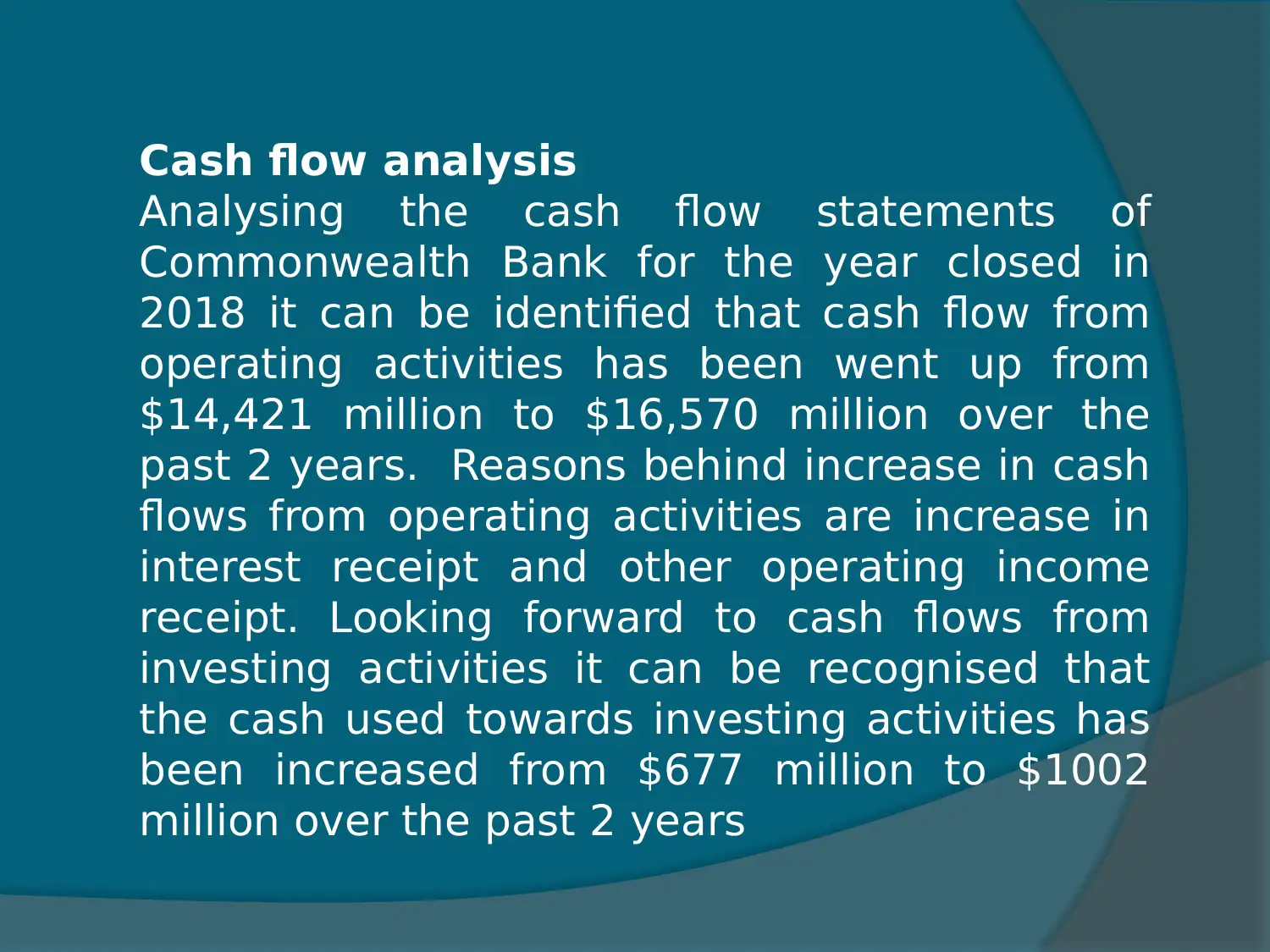
Cash flow analysis
Analysing the cash flow statements of
Commonwealth Bank for the year closed in
2018 it can be identified that cash flow from
operating activities has been went up from
$14,421 million to $16,570 million over the
past 2 years. Reasons behind increase in cash
flows from operating activities are increase in
interest receipt and other operating income
receipt. Looking forward to cash flows from
investing activities it can be recognised that
the cash used towards investing activities has
been increased from $677 million to $1002
million over the past 2 years
Analysing the cash flow statements of
Commonwealth Bank for the year closed in
2018 it can be identified that cash flow from
operating activities has been went up from
$14,421 million to $16,570 million over the
past 2 years. Reasons behind increase in cash
flows from operating activities are increase in
interest receipt and other operating income
receipt. Looking forward to cash flows from
investing activities it can be recognised that
the cash used towards investing activities has
been increased from $677 million to $1002
million over the past 2 years
⊘ This is a preview!⊘
Do you want full access?
Subscribe today to unlock all pages.

Trusted by 1+ million students worldwide
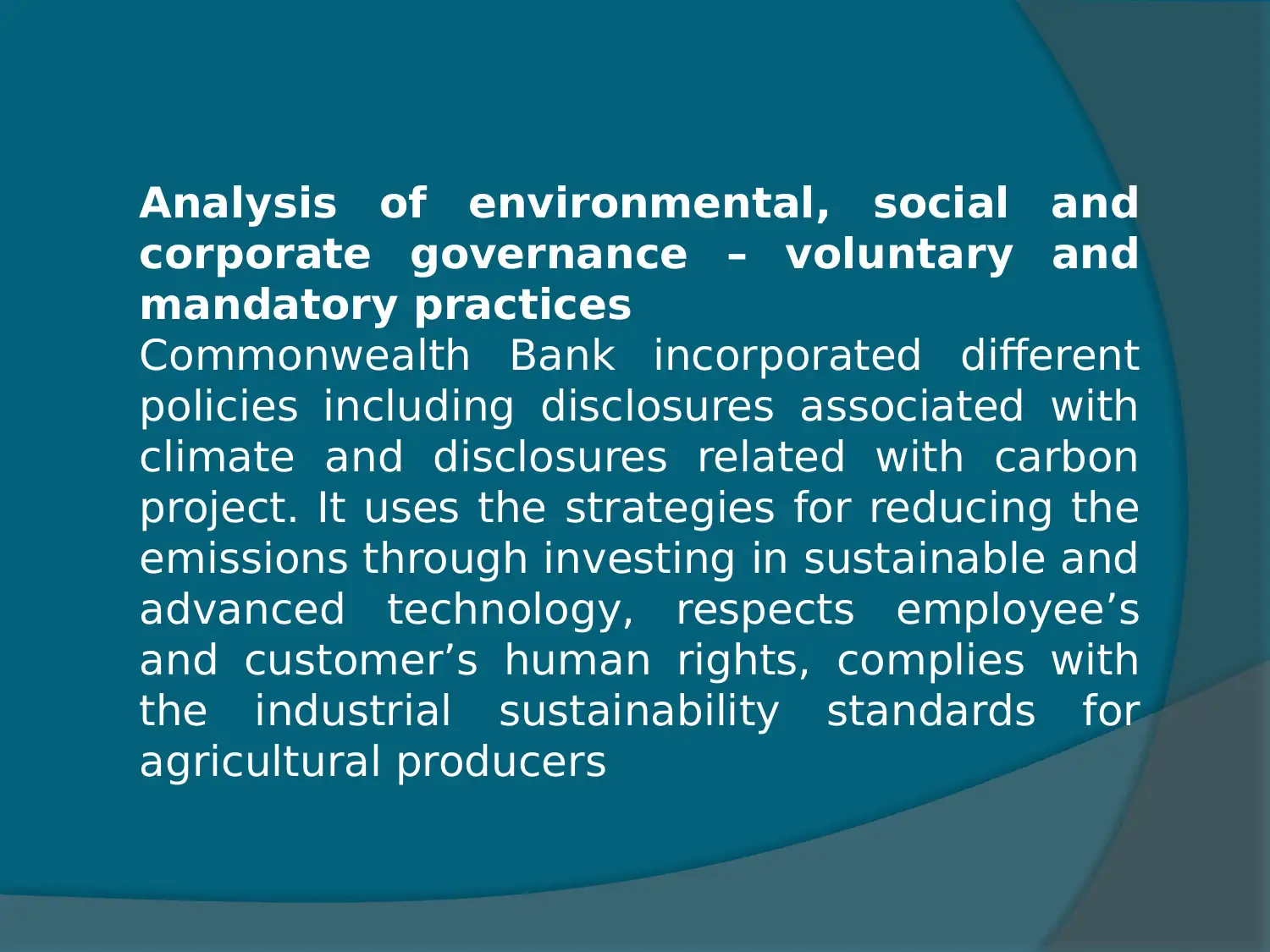
Analysis of environmental, social and
corporate governance – voluntary and
mandatory practices
Commonwealth Bank incorporated different
policies including disclosures associated with
climate and disclosures related with carbon
project. It uses the strategies for reducing the
emissions through investing in sustainable and
advanced technology, respects employee’s
and customer’s human rights, complies with
the industrial sustainability standards for
agricultural producers
corporate governance – voluntary and
mandatory practices
Commonwealth Bank incorporated different
policies including disclosures associated with
climate and disclosures related with carbon
project. It uses the strategies for reducing the
emissions through investing in sustainable and
advanced technology, respects employee’s
and customer’s human rights, complies with
the industrial sustainability standards for
agricultural producers
Paraphrase This Document
Need a fresh take? Get an instant paraphrase of this document with our AI Paraphraser
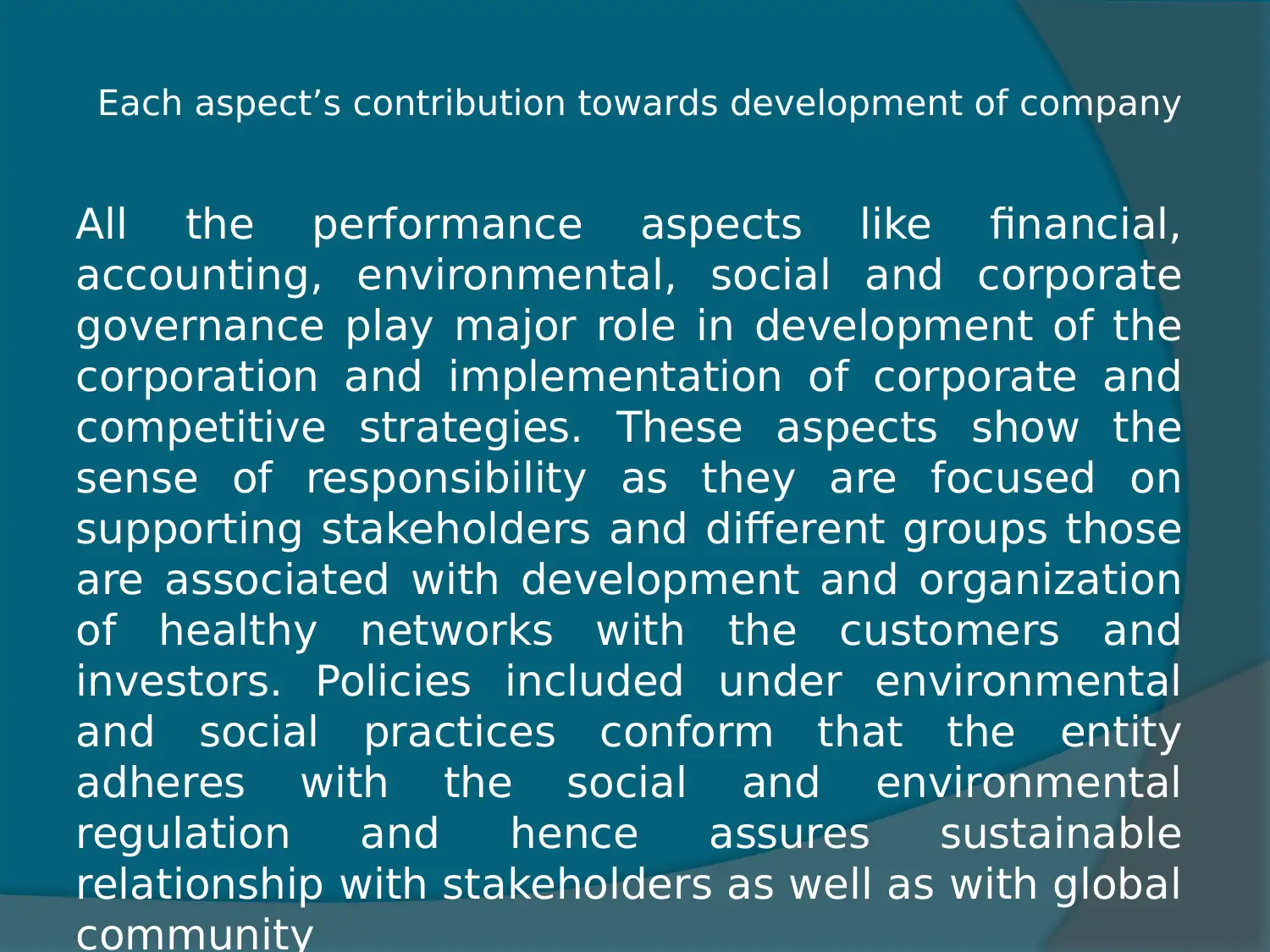
Each aspect’s contribution towards development of company
All the performance aspects like financial,
accounting, environmental, social and corporate
governance play major role in development of the
corporation and implementation of corporate and
competitive strategies. These aspects show the
sense of responsibility as they are focused on
supporting stakeholders and different groups those
are associated with development and organization
of healthy networks with the customers and
investors. Policies included under environmental
and social practices conform that the entity
adheres with the social and environmental
regulation and hence assures sustainable
relationship with stakeholders as well as with global
community
All the performance aspects like financial,
accounting, environmental, social and corporate
governance play major role in development of the
corporation and implementation of corporate and
competitive strategies. These aspects show the
sense of responsibility as they are focused on
supporting stakeholders and different groups those
are associated with development and organization
of healthy networks with the customers and
investors. Policies included under environmental
and social practices conform that the entity
adheres with the social and environmental
regulation and hence assures sustainable
relationship with stakeholders as well as with global
community
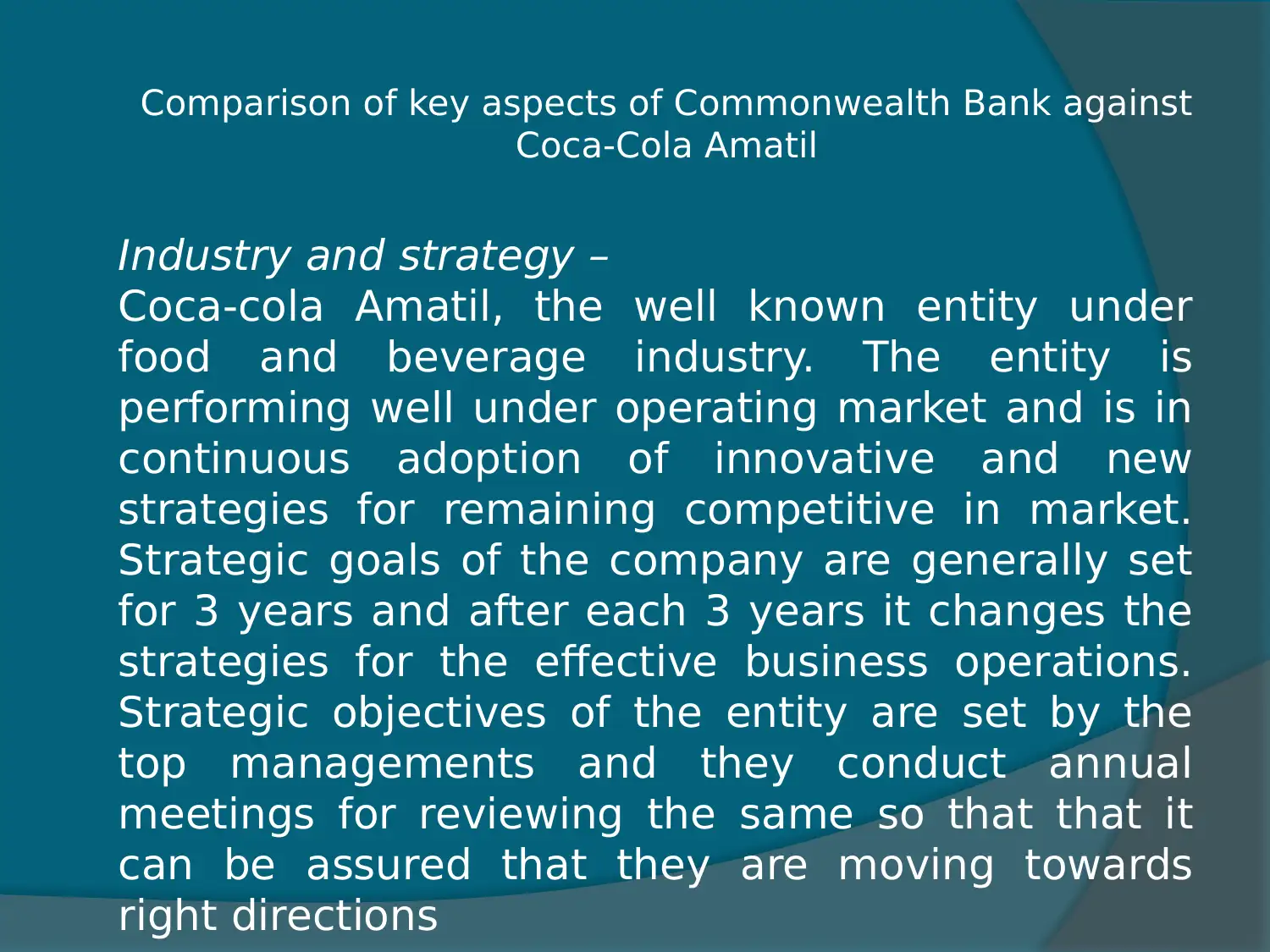
Comparison of key aspects of Commonwealth Bank against
Coca-Cola Amatil
Industry and strategy –
Coca-cola Amatil, the well known entity under
food and beverage industry. The entity is
performing well under operating market and is in
continuous adoption of innovative and new
strategies for remaining competitive in market.
Strategic goals of the company are generally set
for 3 years and after each 3 years it changes the
strategies for the effective business operations.
Strategic objectives of the entity are set by the
top managements and they conduct annual
meetings for reviewing the same so that that it
can be assured that they are moving towards
right directions
Coca-Cola Amatil
Industry and strategy –
Coca-cola Amatil, the well known entity under
food and beverage industry. The entity is
performing well under operating market and is in
continuous adoption of innovative and new
strategies for remaining competitive in market.
Strategic goals of the company are generally set
for 3 years and after each 3 years it changes the
strategies for the effective business operations.
Strategic objectives of the entity are set by the
top managements and they conduct annual
meetings for reviewing the same so that that it
can be assured that they are moving towards
right directions
⊘ This is a preview!⊘
Do you want full access?
Subscribe today to unlock all pages.

Trusted by 1+ million students worldwide
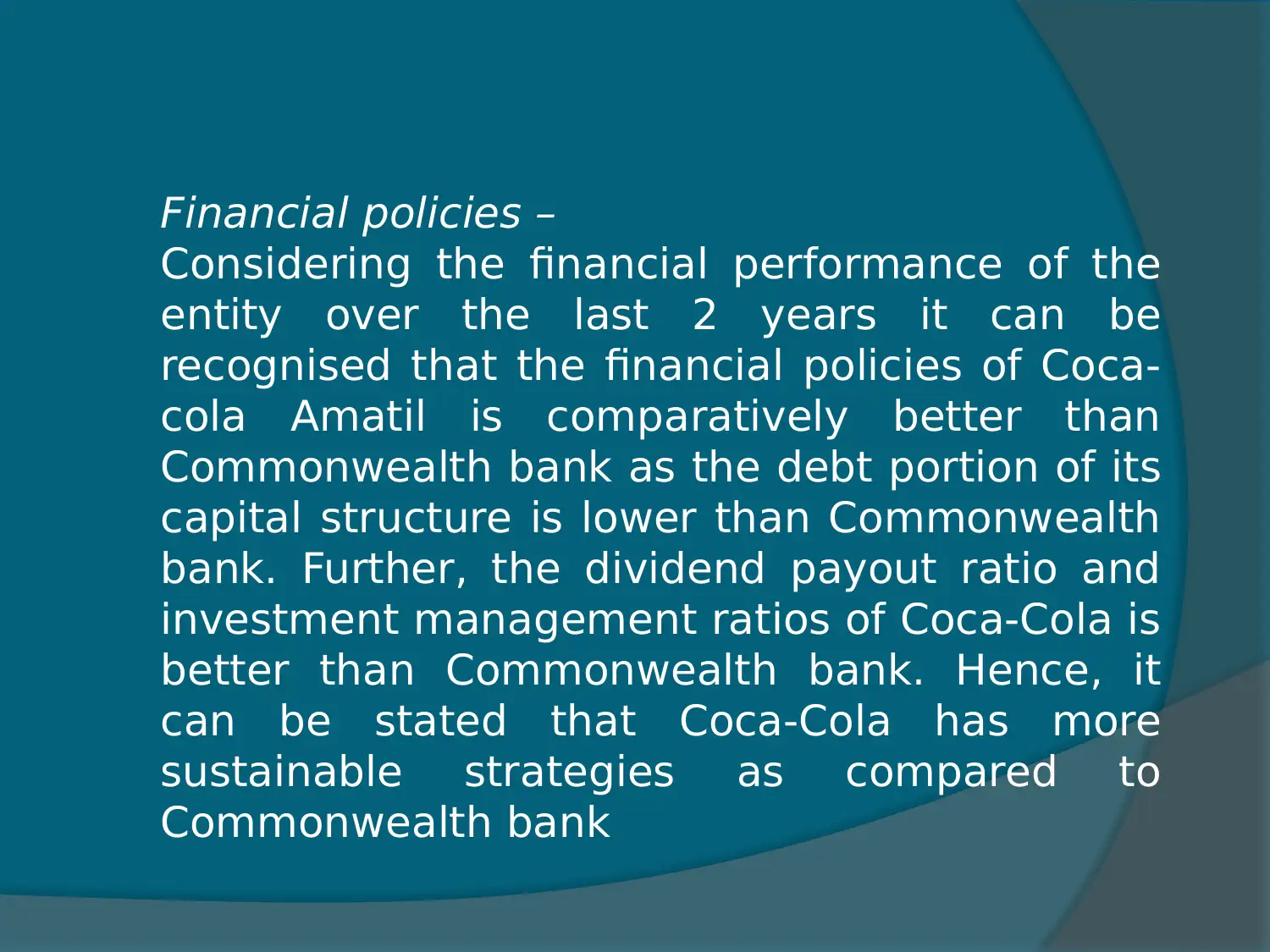
Financial policies –
Considering the financial performance of the
entity over the last 2 years it can be
recognised that the financial policies of Coca-
cola Amatil is comparatively better than
Commonwealth bank as the debt portion of its
capital structure is lower than Commonwealth
bank. Further, the dividend payout ratio and
investment management ratios of Coca-Cola is
better than Commonwealth bank. Hence, it
can be stated that Coca-Cola has more
sustainable strategies as compared to
Commonwealth bank
Considering the financial performance of the
entity over the last 2 years it can be
recognised that the financial policies of Coca-
cola Amatil is comparatively better than
Commonwealth bank as the debt portion of its
capital structure is lower than Commonwealth
bank. Further, the dividend payout ratio and
investment management ratios of Coca-Cola is
better than Commonwealth bank. Hence, it
can be stated that Coca-Cola has more
sustainable strategies as compared to
Commonwealth bank
Paraphrase This Document
Need a fresh take? Get an instant paraphrase of this document with our AI Paraphraser
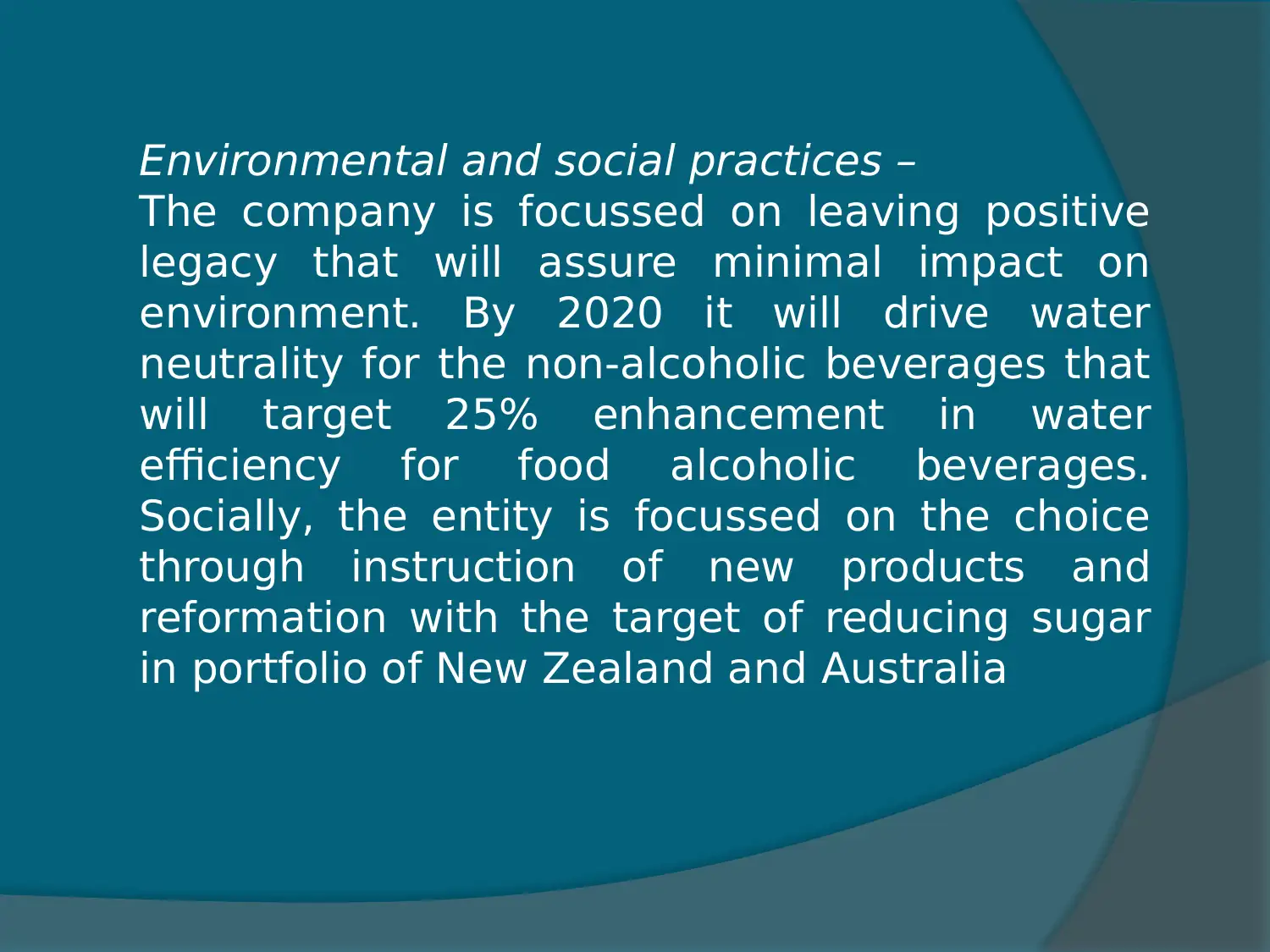
Environmental and social practices –
The company is focussed on leaving positive
legacy that will assure minimal impact on
environment. By 2020 it will drive water
neutrality for the non-alcoholic beverages that
will target 25% enhancement in water
efficiency for food alcoholic beverages.
Socially, the entity is focussed on the choice
through instruction of new products and
reformation with the target of reducing sugar
in portfolio of New Zealand and Australia
The company is focussed on leaving positive
legacy that will assure minimal impact on
environment. By 2020 it will drive water
neutrality for the non-alcoholic beverages that
will target 25% enhancement in water
efficiency for food alcoholic beverages.
Socially, the entity is focussed on the choice
through instruction of new products and
reformation with the target of reducing sugar
in portfolio of New Zealand and Australia
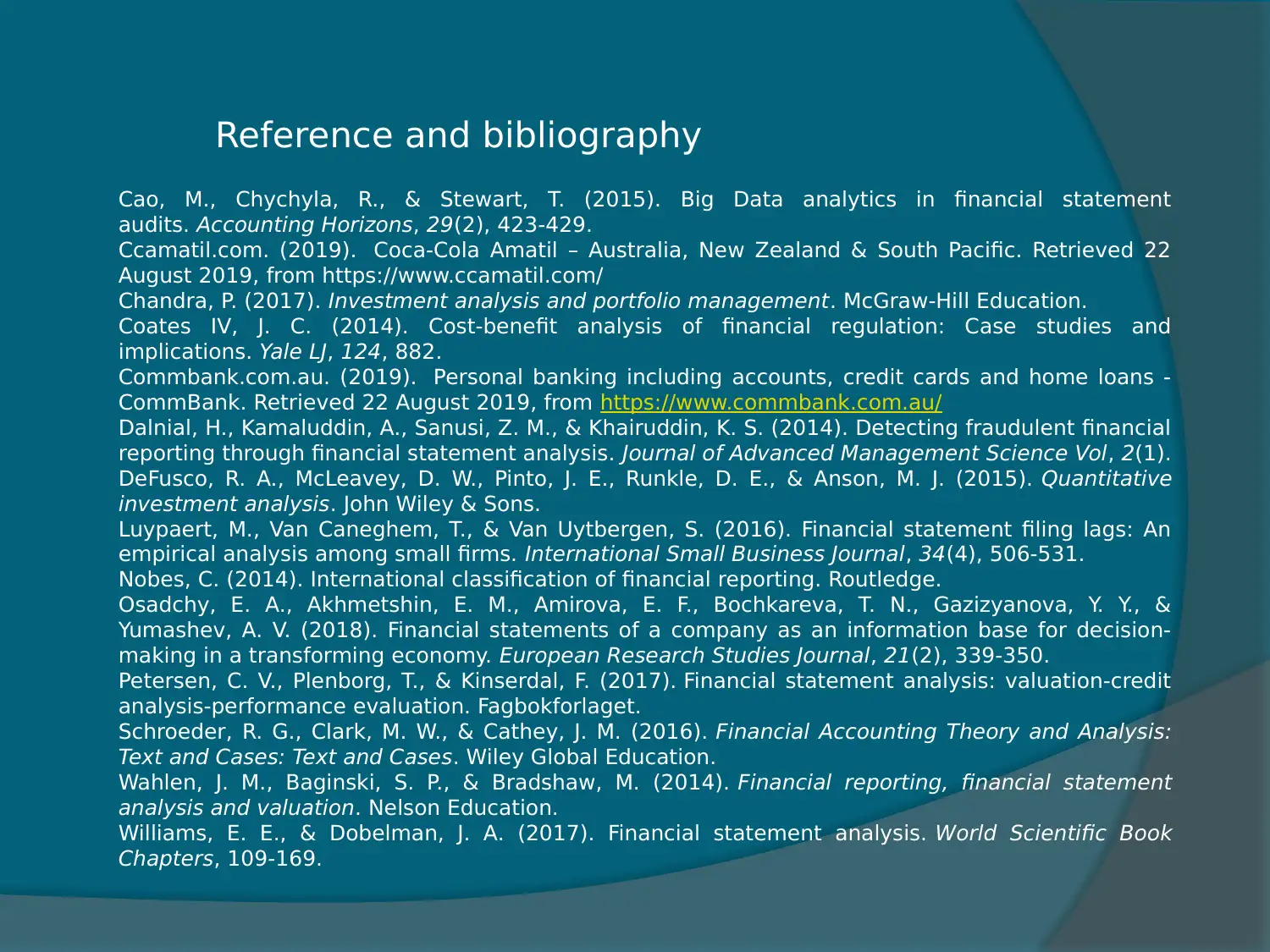
Reference and bibliography
Cao, M., Chychyla, R., & Stewart, T. (2015). Big Data analytics in financial statement
audits. Accounting Horizons, 29(2), 423-429.
Ccamatil.com. (2019). Coca-Cola Amatil – Australia, New Zealand & South Pacific. Retrieved 22
August 2019, from https://www.ccamatil.com/
Chandra, P. (2017). Investment analysis and portfolio management. McGraw-Hill Education.
Coates IV, J. C. (2014). Cost-benefit analysis of financial regulation: Case studies and
implications. Yale LJ, 124, 882.
Commbank.com.au. (2019). Personal banking including accounts, credit cards and home loans -
CommBank. Retrieved 22 August 2019, from https://www.commbank.com.au/
Dalnial, H., Kamaluddin, A., Sanusi, Z. M., & Khairuddin, K. S. (2014). Detecting fraudulent financial
reporting through financial statement analysis. Journal of Advanced Management Science Vol, 2(1).
DeFusco, R. A., McLeavey, D. W., Pinto, J. E., Runkle, D. E., & Anson, M. J. (2015). Quantitative
investment analysis. John Wiley & Sons.
Luypaert, M., Van Caneghem, T., & Van Uytbergen, S. (2016). Financial statement filing lags: An
empirical analysis among small firms. International Small Business Journal, 34(4), 506-531.
Nobes, C. (2014). International classification of financial reporting. Routledge.
Osadchy, E. A., Akhmetshin, E. M., Amirova, E. F., Bochkareva, T. N., Gazizyanova, Y. Y., &
Yumashev, A. V. (2018). Financial statements of a company as an information base for decision-
making in a transforming economy. European Research Studies Journal, 21(2), 339-350.
Petersen, C. V., Plenborg, T., & Kinserdal, F. (2017). Financial statement analysis: valuation-credit
analysis-performance evaluation. Fagbokforlaget.
Schroeder, R. G., Clark, M. W., & Cathey, J. M. (2016). Financial Accounting Theory and Analysis:
Text and Cases: Text and Cases. Wiley Global Education.
Wahlen, J. M., Baginski, S. P., & Bradshaw, M. (2014). Financial reporting, financial statement
analysis and valuation. Nelson Education.
Williams, E. E., & Dobelman, J. A. (2017). Financial statement analysis. World Scientific Book
Chapters, 109-169.
Cao, M., Chychyla, R., & Stewart, T. (2015). Big Data analytics in financial statement
audits. Accounting Horizons, 29(2), 423-429.
Ccamatil.com. (2019). Coca-Cola Amatil – Australia, New Zealand & South Pacific. Retrieved 22
August 2019, from https://www.ccamatil.com/
Chandra, P. (2017). Investment analysis and portfolio management. McGraw-Hill Education.
Coates IV, J. C. (2014). Cost-benefit analysis of financial regulation: Case studies and
implications. Yale LJ, 124, 882.
Commbank.com.au. (2019). Personal banking including accounts, credit cards and home loans -
CommBank. Retrieved 22 August 2019, from https://www.commbank.com.au/
Dalnial, H., Kamaluddin, A., Sanusi, Z. M., & Khairuddin, K. S. (2014). Detecting fraudulent financial
reporting through financial statement analysis. Journal of Advanced Management Science Vol, 2(1).
DeFusco, R. A., McLeavey, D. W., Pinto, J. E., Runkle, D. E., & Anson, M. J. (2015). Quantitative
investment analysis. John Wiley & Sons.
Luypaert, M., Van Caneghem, T., & Van Uytbergen, S. (2016). Financial statement filing lags: An
empirical analysis among small firms. International Small Business Journal, 34(4), 506-531.
Nobes, C. (2014). International classification of financial reporting. Routledge.
Osadchy, E. A., Akhmetshin, E. M., Amirova, E. F., Bochkareva, T. N., Gazizyanova, Y. Y., &
Yumashev, A. V. (2018). Financial statements of a company as an information base for decision-
making in a transforming economy. European Research Studies Journal, 21(2), 339-350.
Petersen, C. V., Plenborg, T., & Kinserdal, F. (2017). Financial statement analysis: valuation-credit
analysis-performance evaluation. Fagbokforlaget.
Schroeder, R. G., Clark, M. W., & Cathey, J. M. (2016). Financial Accounting Theory and Analysis:
Text and Cases: Text and Cases. Wiley Global Education.
Wahlen, J. M., Baginski, S. P., & Bradshaw, M. (2014). Financial reporting, financial statement
analysis and valuation. Nelson Education.
Williams, E. E., & Dobelman, J. A. (2017). Financial statement analysis. World Scientific Book
Chapters, 109-169.
⊘ This is a preview!⊘
Do you want full access?
Subscribe today to unlock all pages.

Trusted by 1+ million students worldwide
1 out of 13
Related Documents
Your All-in-One AI-Powered Toolkit for Academic Success.
+13062052269
info@desklib.com
Available 24*7 on WhatsApp / Email
![[object Object]](/_next/static/media/star-bottom.7253800d.svg)
Unlock your academic potential
Copyright © 2020–2025 A2Z Services. All Rights Reserved. Developed and managed by ZUCOL.





